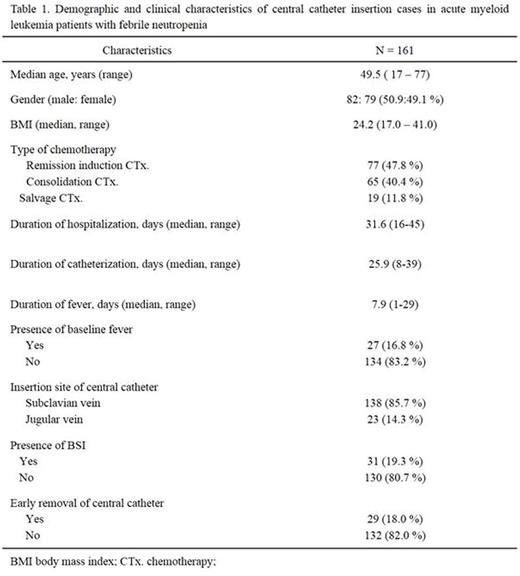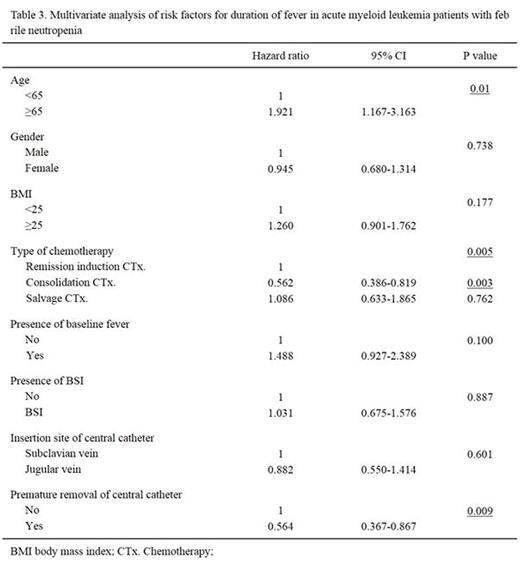Abstract
Background: Febrile neutropenia is considered a medical emergency and generally prompts immediate hospitalization. For this reason, many physicians and researchers have tried some attempts to reduce the duration of febrile neutropenia. Patients with hematologic disorders frequently require the insertion of medium or long-term central venous catheters (CVCs) for stem-cell transplantation, the administration of chemotherapy, or transfusion of blood products. We have already known that the CVC is a major source of bloodstream infections in the neutropenic patients, but, there have been no reports about the duration of febrile neutropenia in the cases with early removal of CVCs except for catheter-related blood stream infections (CRBSIs). In this study, we want to investigate the factors influencing the duration of febrile neutropenia including early removal of CVCs except for CRBSIs in the patients diagnosed with acute myeloid leukemia.
Methods: A total of 161 central catheter insertion cases with febrile neutropenia except for CRBSIs in 102 patients were eligible for analysis. CRBSI was defined as the same microorganism grown from at least one percutaneous blood culture and from a culture of the catheter tip (>15 colony-forming units), or a growth of microbes from blood sample drawn from a catheter hub at least 2 hours before microbial growth was detected in a blood sample obtained from a peripheral vein. Patients with blood stream infection (BSI) were defined as those with clinical signs of infection and the microorganism grown from at least one percutaneous blood culture without detecting microorganism from a culture of the catheter tip or from blood sample drawn from a catheter hub. The early removal of CVCs was defined as the removal of CVCs before 21 days from the insertion date of CVC. Duration of fever was investigated according to age, gender, body mass index (BMI), type of chemotherapy, presence of baseline fever, presence of BSI and/or early removal of central catheter by the Kaplan-Meier method and the Log Rank method. Statistical analysis was performed using SPSS software version 13.0 (IBM, Armonk, NY, USA).
Results: Baseline characteristics of total cases were described in Table 1. Univariate and multivariate analysis about duration of fever are summarized in Table 2 and Table 3. Age, type of chemotherapy, presence of baseline fever and early removal of central catheter were significant in the univariate analysis and age, type of chemotherapy and early removal of central catheter were also significant, but, baseline fever was not significant in the multivariate analysis. Furthermore, duration of fever in the remission induction chemotherapy was significantly longer than consolidation chemotherapy, on the other hand, not significantly longer than salvage chemotherapy.
Conclusion : In this retrospective study, age, type of chemotherapy, presence of baseline fever and early removal of central catheter were significant in the univariate analysis. They were equally significant in the multivariate analysis, only except for the presence of baseline fever. It is noteworthy that the cases with early removal of CVCs except for CRBSIs had significant reduction of the duration of febrile neutropenia. We may need active consideration about the early removal of CVCs in the acute myeloid leukemia patients with febrile neutropenia for the purpose of reduction of the duration of febrile neutropenia.
No relevant conflicts of interest to declare.
Author notes
Asterisk with author names denotes non-ASH members.




